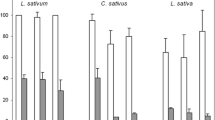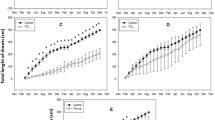Summary
After 10 applications of phenylboric acid (0.03 ml of a 2·10−3 M solution) to young plants ofKalanchoe blossfeldiana the flowers were found to have a reduced number of petals or no petals at all.
InCucumis sativus one application of phenylboric acid at the same strength was enough to cause abnormal flowers to develop in the axils of 8 to 10 leaves; in addition there were 1 to 2 leafles nodes and other abnormalities. The position of the abnormal flowers and leafless nodes was dependant upon the stage of development of the plant at the time of application. It seems from a parallel study of treated plants grown to maturity, and plants sectioned at the time of treatment, that phenylboric acidinhibited selectively the first differentiation processes of the leaf primordia.
Similar content being viewed by others
Literatur
Bugnon, F.: Valeur morphologique du complexe axillaire chez les cucurbitacées. Ann. Sci. natur., Bot., XI. s.17, 313 (1956).
Camp, W. H., andF. G. Liming: The use of basic fuchsin in plant anatomy. Stain Technol.7, 91 (1932).
Caujolle, F., etG. Bergal: Influence de l'acide phénylborique sur la germination de quelques Apétales. C. R. Acad. Sci. (Paris)228, 1249 (1949a).
——: Influence comparée des acides borique et phénylborique sur le développement des plantules de quelques Apétales. C. R. Acad. Sci. (Paris)228, 1516 (1949b).
——: Influence de l'acide phénylborique sur la croissance des racines isolées deRaphanus sativus en milieu liquide sterile. C. R. Acad. Sci. (Paris)230 1101 (1950a).
——: Influence des acides borique et phénylborique sur la germination et le développement des plantules de quelques dicotylédones. C. R. Acad. Sci. (Paris)231, 1550 (1950b).
Haccius, B.: Morphoregulatorische Beeinflussung pflanzlicher Embryonen durch Phenylborsäure. Naturwissenschaften46, 153 (1959).
—: Experimentell induzierte Einkeimblättrigkeit beiEranthis hiemalis. II. Monokotylie durch Phenylborsäure. Planta (Berl.)54, 482 (1960).
—, u.D. Massfeller.: Durch Phenylborsäure induzierte Reduktion der Petalen beiCucumis sativus. Naturwissenschaften46, 585 (1959).
Hagerup, O.: Vergleichende morphologische und systematische Studien über Ranken und andere vegetative Organe der Cucurbitaceen und Passifloraceen. Dansk. bot. Ark.6, Nr 8 (1930).
Kiermayer, O.: Morphologische, Veränderungen an, Blüten vonKalanchoe Blossfeldiana, sowie den Brutpflanzen vonBryophyllum tubiflorum durch synthetische Wuchs- und Hemmstoffe. Phyton (Argentina)9, 53 (1957).
Straub, J.: Entwicklungsphysiologische Untersuchungen über die Zwei- und Dreizähligkeit der Wirtel vonAntirrhinum majus. Z. Bot.48, 219 (1959).
Torssell, K.: Chemistry of arylboric acids. VI. Effects of arylboric acids on wheat roots and the role of boron in plants. Physiol. Plantarum (Cph.)9, 653 (1956).
Torssell, K., J. H. McClendon andG. F. Somers: Chemistry of arylboric acids. VIII. The relationship between physicochemical properties and activity in plants. Acta chem. scand.12, 1373 (1958).
Author information
Authors and Affiliations
Additional information
Mit 9 Textabbildungen
D 77.
Rights and permissions
About this article
Cite this article
Haccius, B., Massfeller, D. Untersuchungen zur biologischen Aktivität der Phenylborsäure. Planta 56, 174–188 (1961). https://doi.org/10.1007/BF01895007
Received:
Issue Date:
DOI: https://doi.org/10.1007/BF01895007




